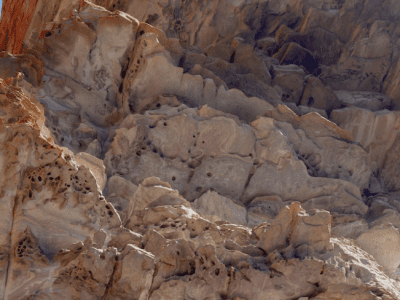Honeycomb Weathering

A few weeks ago I had the pleasure of escorting a group of Year 4 girls from St Catherine’s School, Waverley, on a field excursion to Bondi. There were 66 girls and 6 teachers along with Irene, my wife. Mackenzie Hansen, our granddaughter was in the group. I wish to thank Miss Reid and the school for the opportunity to show the girls aspects of the geology, geomorphology and history of this wonderful place. The trip included a visit to the marvellous Pavilion with its array of historic photos dating back to 1876, an image that records the dunes and vegetation prior to the period of destabilisation in the 1880s.
The girls were studying rock types and landform changes. Besides the obligatory chat about the beach and its quartz rich sands, I was able to show them various features on the cliff and rock platform to the south of Bondi Baths. They were quite curious and many great questions were asked. One object of fascination was the honeycomb weathering on the vertical cliff face that extends along the path between Bondi and Tamarama.
Honeycomb weathering is also known by other terms such as alveolar weathering, tafoni, stone lattice, cavernous weathering, etc. Some authors use these terms differently. The densely pitted forms on vertical faces of rock surfaces can occur in a range of environments. Moreover, its occurrence on historic buildings is now the focus of conservators seeking to lessen the impact of processes that are weakening their fabric. The fact that honeycomb weathering can occur on different types of rock is well known but on this trip the girls were experiencing the joys of observing them on the local Hawkesbury Sandstone.
A paper written in 1999 in the Bulletin of the Geological Society of America by Rodriguez-Navarro et al. (v.111, p. 1250-1255), discusses the origin of honeycomb weathering. They consider that despite work in many places the origin is still controversial. They developed a series of experiments to test the impact of wind exposure and salt crystallisation. Salt heaving is thought to be important, but under what circumstances? Presumably there must be periodic coverage of the surface by water with salt in solution. Evaporation allows for salt crystals to infiltrate the surface in some way so the rock must possess a certain level of permeability. But these authors show that “heterogeneous wind flow over a stone surface is important in the development of this weathering pattern”. Their experiments suggest that wind promotes evaporative salt growth between the grains resulting in small randomly distributed cavities.
The girls noted the occurrence of iron-oxide bands in the Hawkesbury Sandstone that stuck out in and around areas of honeycomb; we call this case hardening. They also observed blackened surfaces free of cavities that were wet; I told them that I thought this was a cover of microscopic black algae. In the literature there are references to algae as protective cover. But what really fascinated some of the girls who managed to get up close and look into the cavities was the loose sand recently detached from the rock.
It was important to see this as it emphasised the on-going nature of weathering at the site. I have noted similar pockets of sand inside honeycomb surfaces on sandstone rocks in the Blue Mountains. It was a memorable experience to show these young folk some of the large and small scale landform features carved into rocks of the Sydney area. I enjoyed their enthusiasm and congratulate the teachers on providing an opportunity for them to examine in the field such magnificent coastal features.
Words by Prof Bruce Thom. Please respect Bruce Thom’s thoughts and reference where appropriately: (c) ACS, 2017, posted 30 June 2017, for correspondence about this blog post please email admin@australiancoastalsociety.org
#82


 Disaster preparedness
Disaster preparedness